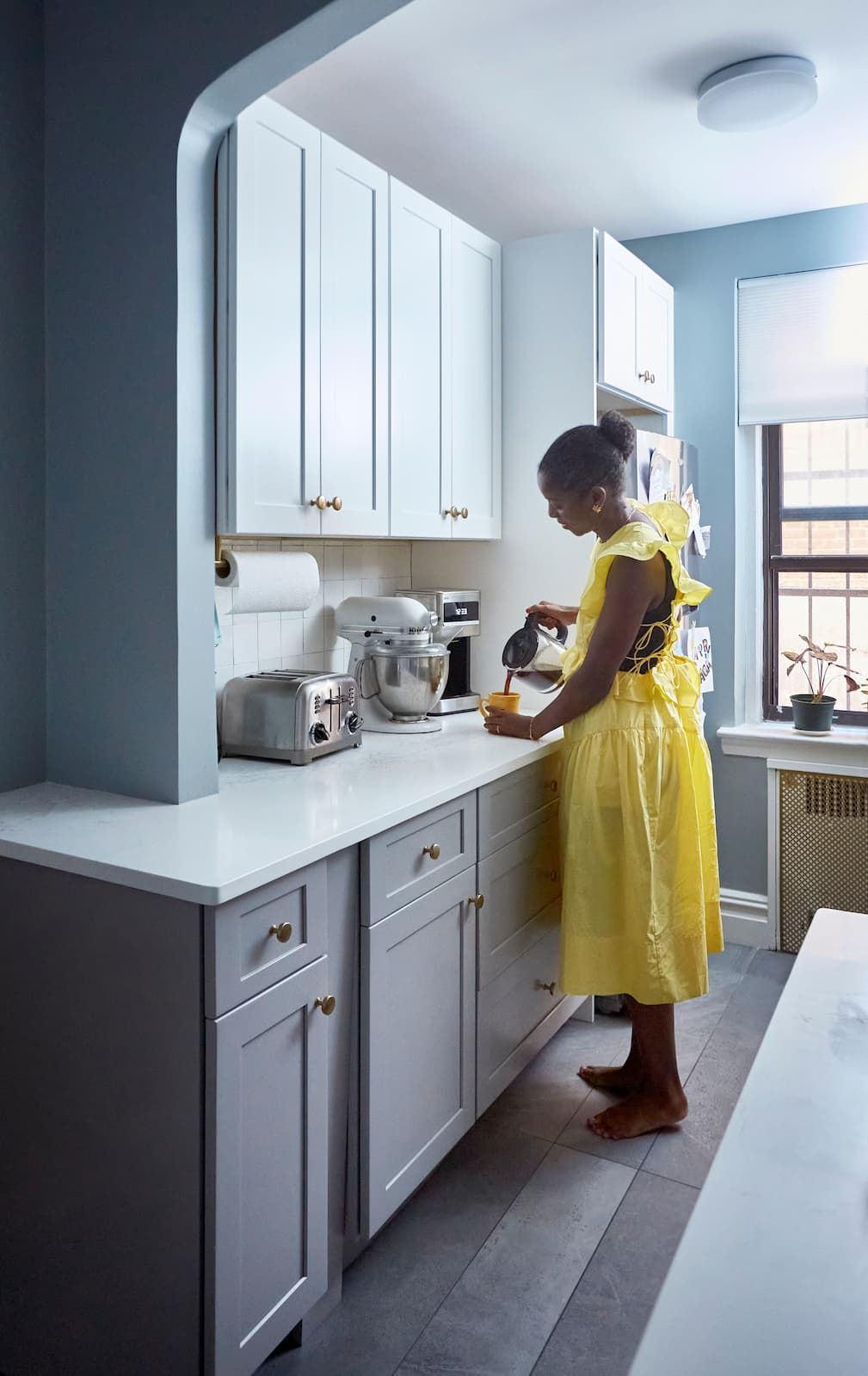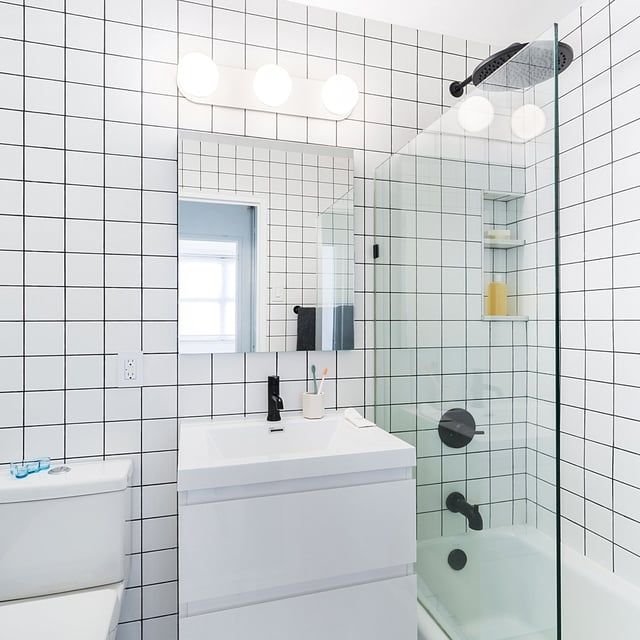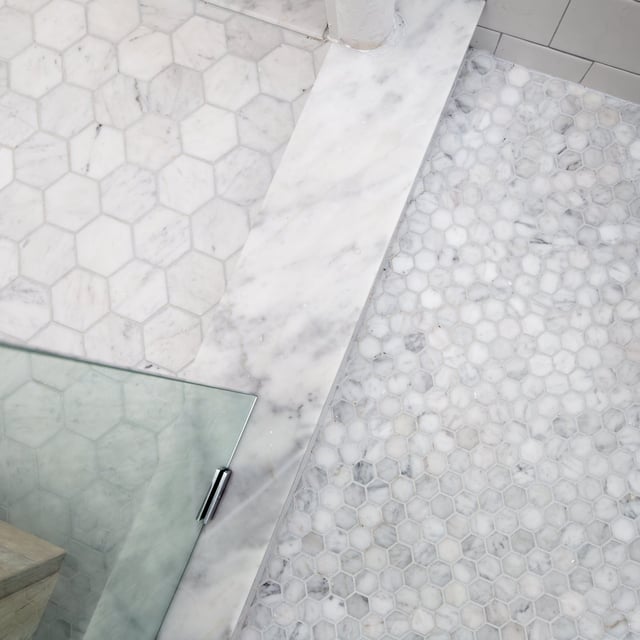
Tile
Subway Tile Pattern Guide: Vertical, Herringbone & More
11.15.2025


In This Article
Natural stone tile flooring brings texture, weight, and individuality to the kitchen. Marble adds cool refinement, slate offers depth and grip, and limestone softens a space with subtle warmth. Because each tile is one-of-a-kind, the result is a floor that feels grounded, durable, and distinctly yours.
Common characteristics of natural stone flooring:
Natural stone flooring comes in a range of textures, colors, and price points. Here’s a glance at the most popular options for kitchen stone tile flooring:
|
Natural stone type |
Cost range (per sq. ft.) |
Characteristics |
|
Marble |
$10–$30+ |
Elegant veining, polished or honed, softer—prone to etching |
|
Granite |
$8–$15 |
Dense, highly durable, wide color/texture range |
|
Limestone |
$5–$15 |
Soft, warm tones, subtle patterning, needs sealing |
|
Slate |
$4–$10 |
Textured, slip-resistant, earthy colors, durable |
|
Travertine |
$6–$16 |
Veined, pitted look; available tumbled or honed |
|
Sandstone |
$5–$12 |
Distinct layering, natural grit, warm tones |
|
Quartzite |
$10–$20 |
Hard, sparkling surface, excellent durability |
To learn more about budgeting your upcoming project, read How Much Does It Cost to Replace a Kitchen Floor in 2025?.
With the right care, your natural stone kitchen floor can look beautiful for decades. Here are steps you can take to keep stone kitchen floor tiles looking their best:
Know the Cost Before You Start

Selecting the perfect natural stone kitchen floor is about blending function, style, and your daily habits. Here’s how to narrow your options:
The right stone tile gives your kitchen a solid foundation that holds up to daily use and supports everything from rushed breakfasts to late-night cleanup. When you understand the options and the care each one needs, you can make choices that fit your life and feel good long after the work is done.
Design a Home That’s Uniquely Yours
Block can help you achieve your renovation goals and bring your dream remodel to life with price assurance and expert support.
Get Started
Consider pairing dark slate or deep charcoal granite with lighter cabinetry to create a balanced contrast that highlights both the flooring and the rest of your kitchen. These stones add a sense of depth and drama, making metallic accents and natural wood tones stand out. For a cohesive look, use lighter grout and reflective surfaces to prevent the space from feeling closed in.
 See how this apartment features dark natural stone
See how this apartment features dark natural stone
Creamy travertine or honey-toned limestone tiles work beautifully with rich wood cabinets and bronze fixtures for a kitchen that feels inviting and grounded. Warm stones soften contemporary spaces and add a layer of comfort alongside warm white or beige walls. Use textured finishes to let in more natural light and complement organic elements like plants or woven accessories.
 View warm natural stone in this remodeled kitchen
View warm natural stone in this remodeled kitchen
White marble or pale gray quartzite pairs naturally with crisp white cabinetry and stainless steel hardware, creating a fresh, airy foundation. Cool-toned stone floor tiles help amplify light in kitchens with limited daylight, making the room feel open and bright. Accentuate the subtle veining or flecks with muted blues or greens in your textiles or backsplash for a calming effect.
 Check out how this kitchen spotlights stone tiles
Check out how this kitchen spotlights stone tiles
Kitchen AI Visualizer: See your kitchen design ideas come to life instantly with Block’s Kitchen AI Visualizer. Experiment with layouts, colors, and materials in real time—no contractor or technical experience required. It’s an easy way to try out bold choices and find inspiration, all from the comfort of home.
Renovation Studio: Block’s Renovation Studio gives you the power to visualize your future kitchen and understand your budget from the very start. Upload photos of your space or start from a template, then view personalized 3D renders with your favorite stone tile flooring, cabinetry, and fixtures. As you discover new possibilities, the Studio provides real-time cost estimates, helping ensure your design aligns with your priorities and budget. With this clear, interactive roadmap, you can make confident decisions before any work begins.
How we pair you with the right kitchen remodelers: Finding a remodeler who understands your vision can feel daunting, but Block simplifies the process by matching you with vetted professionals who specialize in your type of kitchen project. By sharing your goals, style preferences, and functional needs, you receive personalized matches with contractors who have a proven record of quality work and reliability. You’ll also get transparent reviews, access to past project examples, and expert scope reviews—so you feel fully informed and supported at every step.

Written by Block Renovation
How often do I need to seal natural stone tile flooring?
Can you paint stone floors to change their color?
Do natural stone kitchen floors require special installation?
Does natural stone tile flooring increase home value?
Are natural stone floors suitable for households with kids or pets?

Renovate confidently with Block
Easily compare quotes from top quality contractors, and get peace of mind with warranty & price protections.
Thousands of homeowners have renovated with Block

4.5 Stars (100+)

4.7 Stars (100+)

4.5 Stars (75+)

Tile
Subway Tile Pattern Guide: Vertical, Herringbone & More
11.15.2025

Tile
Natural Stone Kitchen Flooring: Tile Types, Cleaning Tips & Design
10.13.2025

Tile
Grout Color Guide: Enhancing White and Colored Tiles
08.27.2025

Tile
Best Materials for Bathroom Floor Tiles
08.21.2025

Tile
Mixing Bathroom Tiles for a Contemporary Look
08.21.2025
Renovate confidently